社会技术变革中的间质沉默——以转基因“无泪”洋葱为例
IF 2.4
3区 哲学
Q1 CULTURAL STUDIES
引用次数: 0
摘要
摘要转基因“无泪”洋葱于2007年在新西兰的一个实验室设施中开发,但启动现场测试的努力没有成功,到2012年,该项目几乎被完全拆除。该项目的总体轨迹受到日本和新西兰科学家团队合作的影响;新西兰科学系统的商业压力;室内与室外研究必须遵循的不同监管程序;以及在通用汽车Brassicas现场测试中发现遏制漏洞的活动人士。导致转基因无泪洋葱最终消亡的因素组合也表明,转基因研究的某些方面没有争议,但如果我们只关注这场争议中存在的问题,这些问题将从我们的分析中消失。因此,将注意力转移到争议中没有的东西上会揭示出“间隙沉默”:这些问题超出了公共辩论的范围,但仍然是社会技术变革整体轨迹的一部分。对间隙沉默的关注有助于通过复杂化对这些参与空间中正在谈判的内容的理解,形成关于参与生态的新兴文献。因此,未来在这一领域的研究应该寻找间隙沉默,并探索如何利用对空间复杂性的理解来进一步重新构想更广泛的参与空间,通过这些空间来协商社会技术变革的轨迹。本文章由计算机程序翻译,如有差异,请以英文原文为准。
Interstitial Silences in Sociotechnical Change: The Case of Genetically Modified ‘Tearless’ Onions
ABSTRACT Genetically modified (GM) ‘tearless’ onions were developed in a New Zealand laboratory facility in 2007, but efforts to initiate a field test were unsuccessful, and by 2012 the project had been almost completely dismantled. The overall trajectory of this project was influenced by a collaboration between teams of scientists in Japan and New Zealand; commercial pressures in the New Zealand science system; different regulatory processes that must be followed for indoor versus outdoor research; and activists who detected a containment breach in a GM Brassicas field test. The combination of factors that led to the ultimate demise of GM tearless onions also reveals that some aspects of GM research are not subject to debate, but these would be missing from our analysis if we had only focused on what is present in this controversy. Hence, shifting attention to what is absent from controversy reveals ‘interstitial silences’: matters that lie beyond the boundaries of public debate, but are nevertheless part of the overall trajectory of sociotechnical change. An attention to interstitial silences contributes to an emerging literature on the ecologies of participation by complexifying understandings of what is being negotiated in these participatory spaces. Future research in this area should therefore search for interstitial silences, and also explore how understandings of spatial complexity could be used to further reimagine the wider spaces of participation through which trajectories of sociotechnical change are negotiated.
求助全文
通过发布文献求助,成功后即可免费获取论文全文。
去求助
来源期刊

Science As Culture
Multiple-
CiteScore
5.20
自引率
3.80%
发文量
28
期刊介绍:
Our culture is a scientific one, defining what is natural and what is rational. Its values can be seen in what are sought out as facts and made as artefacts, what are designed as processes and products, and what are forged as weapons and filmed as wonders. In our daily experience, power is exercised through expertise, e.g. in science, technology and medicine. Science as Culture explores how all these shape the values which contend for influence over the wider society. Science mediates our cultural experience. It increasingly defines what it is to be a person, through genetics, medicine and information technology. Its values get embodied and naturalized in concepts, techniques, research priorities, gadgets and advertising. Many films, artworks and novels express popular concerns about these developments. In a society where icons of progress are drawn from science, technology and medicine, they are either celebrated or demonised. Often their progress is feared as ’unnatural’, while their critics are labelled ’irrational’. Public concerns are rebuffed by ostensibly value-neutral experts and positivist polemics. Yet the culture of science is open to study like any other culture. Cultural studies analyses the role of expertise throughout society. Many journals address the history, philosophy and social studies of science, its popularisation, and the public understanding of society.
 求助内容:
求助内容: 应助结果提醒方式:
应助结果提醒方式:


